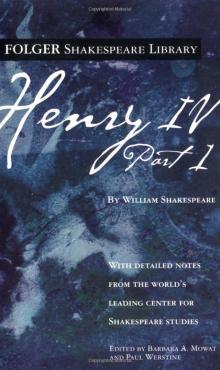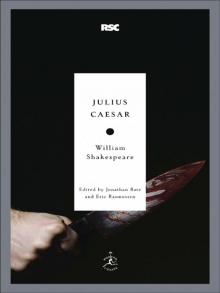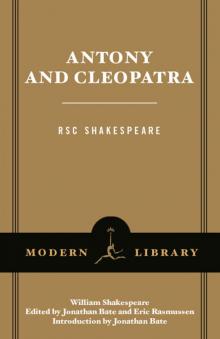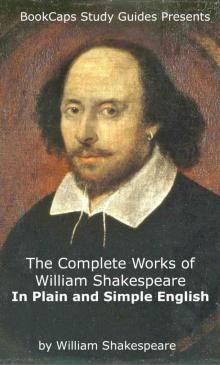- Home
- William Shakespeare
Henry IV, Part 2 Page 2
Henry IV, Part 2 Read online
Page 2
Iambic pentamenter is the ideal medium for dramatic poetry in English because its rhythm and duration seem to fall in naturally with the speech patterns of the language. In its capacity to combine the ordinary variety of speech with the heightened precision of poetry, the supple mature Shakespearean “loose pentameter” is perhaps the most expressive vocal instrument ever given to the actor. The development in the suppleness of Shakespearean verse is apparent if we compare the highly formalized language in which King Henry VI meditates on mortality in his play, written about 1591,
…then to divide the times:
So many hours must I tend my flock,
So many hours must I take my rest,
So many hours must I contemplate,
So many hours must I sport myself,
So many days my ewes have been with young,
So many weeks ere the poor fools will ean,
So many years ere I shall shear the fleece.
So minutes, hours, days, months and years,
Passed over to the end they were created,
Would bring white hairs unto a quiet grave.
and the fluid idiom in which King Henry IV addresses a similar theme in his night scene, written seven or eight years later:
…That one might read the book of fate,
And see the revolution of the times
Make mountains level, and the continent,
Weary of solid firmness, melt itself
Into the sea. And other times, to see
The beachy girdle of the ocean
Too wide for Neptune’s hips; how chance’s mocks
And changes fill the cup of alteration
With divers liquors!…
Whereas the early passage conveys the metronomic beat of the clock, the later one conveys a more complex sense of the movement of human time, and thus of history, in which the movement of the verse ebbs and flows like the ocean to which it is compared.
Perhaps the greatest difference between the two parts of Henry IV is the sense in which Part II is suffused with a pervasive consciousness of time, of age, and of mortality.
THE REFORMATION OF ENGLAND?
It is not known whether Shakespeare always intended Henry IV to be a two-part play or whether he discovered at some point in the writing or production of Part I that it would be dramatically unsatisfying to contain a double climax in a single play, to have Prince Harry prove himself a chivalric hero by defeating Hotspur on the battlefield and then immediately dissociate himself from Falstaff and the other thieves. Instead, the rejection of Falstaff is withheld until Part II, but anticipated in the play-within-the-play in Part I, where the prince’s return to his father is pre-enacted in the tavern.
There is little historical warrant for the story of Henry V’s riotous youth. A “prodigal son” narrative was attached to him in the Chronicles and the anonymous play The Famous Victories of Henry the Fifth in order to highlight the change he undergoes when he becomes king, submits to the rule of law, and so unifies and brings to order the nation that his father divided. The rejection of Falstaff and company is part and parcel of Harry’s symbolically becoming a new person at the moment of his coronation. The notions of “reformation” and the washing away of past iniquities clearly have strong religious connotations. Each time the prince returns to the court, he speaks a language of “fall” and “pardon.” When he fights well, his father tells him that “Thou hast redeemed thy lost opinion.”
The rhythm of Prince Hal’s life is that of providential history, leading to his “reformation” and his assumption of the roles that attracted Queen Elizabeth to him: unifier of the body politic, victor over a rival kingdom, heroic leader of a great and independent nation. The rhythm of Falstaff’s life is that of the body and the seasons. In Part II he will journey into the deep England of Justice Shallow’s Gloucestershire orchard. We learn from Shallow that Falstaff began his career as page to Thomas Mowbray, Duke of Norfolk. This appears to be a Shakespearean fancy without source: it is true of neither the historical Sir John Falstaff, who flees the battlefield in Henry VI Part I, nor the historical Sir John Oldcastle, of whom the character of Falstaff was originally an irreverent portrait. Why did Shakespeare give his fictional Falstaff a past that began in the service of Mowbray? At one level, it links him with opposition to the Lancastrian ascendancy represented by King Henry IV and his son. Mowbray was Henry IV’s opponent when the latter was still Bullingbrook, back at the beginning of Richard II. Like father, like son: as Bullingbrook’s accusation of treachery was instrumental in the banishment of Mowbray from the land, so Hal will banish Falstaff from his presence. Mowbray departs with a moving farewell to his native land and language; the effect of his words is to suggest that love of the English earth and the English word goes deeper than dynastic difference. We do not hear similar patriotic sentiments in the mouth of the self-interested Bullingbrook; he does nothing to bring back the old England idealized in the deathbed speech of his father, John of Gaunt (whose name and whose England will also be remembered by Shallow).
In Shakespeare’s own time, those who suffered banishment because of ideological difference, but who claimed that they were nevertheless loyal to England, were predominantly Catholics. And this suggests another level to the allusion that binds Falstaff to the Duke of Norfolk. To an Elizabethan audience, the name of Norfolk—the only surviving dukedom in the land—was synonymous with overt or suspected Catholic sympathy. The old Catholic ways persisted in the country long after the official change of religion inaugurated by Henry VIII’s break from Rome. The Catholic liturgy’s integral relationship with the agricultural calendar and the cycles of human biology could not be shattered overnight. There may, then, be a sense in which Falstaff’s journey into deep England is also a journey into the old religion of Shakespeare’s father and maternal grandfather. One wonders if it is a coincidence that, in fleshing out the skeletal character of the prince’s riotous companion which he inherited from the old play of The Famous Victories of Henry the Fifth, Shakespeare retained and made much of his own father’s name, John. It is ironic that Falstaff’s original surname, Oldcastle, had to be changed because the character was regarded as an insult to the memory of the proto-Protestant Lollard of that name: “for Oldcastle died a martyr,” says the epilogue to Part II, “and this is not the man.”
Indeed, it is not the man, for Falstaff is if anything an embodiment of those ancient Catholic rhythms that were suppressed in the name of Reformation. Vestiges of Oldcastle litter the text: “Falstaff sweats to death” suggests a martyr burning on a bonfire, and “if I become not a cart as well as another man” could suggest a religious dissident on the way to the stake as well as a criminal being taken to the gallows. Protestants, especially in the extreme form of puritans, were traditionally lean; fat monks were symbolic of the corruptions of Catholicism. By making Sir John fat and not calling him Oldcastle, Shakespeare raises the specter of Catholic as opposed to Protestant martyrdoms. Falstaff is Malvolio’s opposite: he stands for cakes and ale, festival and holiday, all that was anathema to puritanism. At the beginning of Henry V, the Archbishop of Canterbury confirms that Prince Harry’s transformation was completed with the rejection of Falstaff: “Never came reformation in a flood, / With such a heady currance, scouring faults.” If there is a proto-Protestant or embryonic puritan in the plays, it is King Harry V, newly washed of his past, casting off his old companions, turning away England’s former self.
Even as he uses Hal for his own advancement, Falstaff is always a truer father than the cold and politic King Henry IV can ever be. The point is made with beautiful clarity by the contrast between Falstaff’s heated engagement in the scene in which he and Hal act out the prodigal prince’s forthcoming interview with his father and the king’s chilly detachment in the interview itself. The complexity and the pain of the end of Part II stem from the way in which, by casting himself as the prodigal son and coming home to his politic heritage, Hal tears into the heart of old England. According to
Holinshed’s Chronicles, King Henry V left no friendship unrewarded. This cannot be said of Shakespeare’s version of history. “Master Shallow, I owe you a thousand pound,” says Falstaff immediately after he has been publicly denounced by his “sweet boy,” changing the subject in the way that people often do when they feel betrayed or bewildered. At this moment, the spectator who has attended carefully to both parts may remember an earlier exchange when Hal asks: “Sirrah, do I owe you a thousand pound?,” and Falstaff replies: “A thousand pound, Hal? A million. Thy love is worth a million: thou ow’st me thy love.”
In the epilogue, Shakespeare promises that “our humble author will continue the story, with Sir John in it, and make you merry with fair Katherine of France.” Audience members attending Henry V on the basis of this promise might be justified in asking for their money back: we do not see Sir John Falstaff in the Agincourt play. His presence would raise too many awkward questions of the “reformed” king. We only hear—most comically and at the same time most movingly—of his death. The king has broken his heart.
* Since the play is a continuation of Henry IV Part I, some sections of this introduction overlap with that to the companion edition of Part I. Readers who are unfamiliar with Part Imay wish to begin by reading the synopsis of its plot.
ABOUT THE TEXT
Shakespeare endures through history. He illuminates later times as well as his own. He helps us to understand the human condition. But he cannot do this without a good text of the plays. Without editions there would be no Shakespeare. That is why every twenty years or so throughout the last three centuries there has been a major new edition of his complete works. One aspect of editing is the process of keeping the texts up to date—modernizing the spelling, punctuation, and typography (though not, of course, the actual words), providing explanatory notes in the light of changing educational practices (a generation ago, most of Shakespeare’s classical and biblical allusions could be assumed to be generally understood, but now they can’t).
But because Shakespeare did not personally oversee the publication of his plays, editors also have to make decisions about the relative authority of the early printed editions. Half of the sum of his plays only appeared posthumously, in the elaborately produced First Folio text of 1623, the original “Complete Works” prepared for the press by Shakespeare’s fellow actors, the people who knew the plays better than anyone else. The other half had appeared in print in his lifetime, in the more compact and cheaper form of “Quarto” editions, some of which reproduced good quality texts, others of which were to a greater or lesser degree garbled and error-strewn. In the case of a few plays there are hundreds of differences between the Quarto and Folio editions, some of them far from trivial.
If you look at printers’ handbooks from the age of Shakespeare, you quickly discover that one of the first rules was that, whenever possible, compositors were recommended to set their type from existing printed books rather than manuscripts. This was the age before mechanical typesetting, where each individual letter had to be picked out by hand from the compositor’s case and placed on a stick (upside down and back to front) before being laid on the press. It was an age of murky rush-light and of manuscripts written in a secretary hand that had dozens of different, hard-to-decipher forms. Printers’ lives were a lot easier when they were reprinting existing books rather than struggling with handwritten copy. Easily the quickest way to have created the First Folio would have been simply to reprint those eighteen plays that had already appeared in Quarto and only work from manuscript on the other eighteen.
But that is not what happened. Whenever Quartos were used, playhouse “promptbooks” were also consulted and stage directions copied in from them. And in the case of several major plays where a reasonably well-printed Quarto was available, the Folio printers were instructed to work from an alternative, playhouse-derived manuscript. This meant that the whole process of producing the first complete Shakespeare took months, even years, longer than it might have done. But for the men overseeing the project, John Hemings and Henry Condell, friends and fellow actors who had been remembered in Shakespeare’s will, the additional labor and cost were worth the effort for the sake of producing an edition that was close to the practice of the theater. They wanted all the plays in print so that people could, as they wrote in their prefatory address to the reader, “read him and again and again,” but they also wanted “the great variety of readers” to work from texts that were close to the theater-life for which Shakespeare originally intended them. For this reason, the RSC Shakespeare, in both Complete Works and individual volumes, uses the Folio as base text wherever possible. Significant Quarto variants are, however, noted in the Textual Notes.
Henry IV Part II is one of the plays where the Folio text was printed from a manuscript that shows strong signs of theatrical influence, not from an available printed Quarto. It contains eight significant passages that are absent—perhaps because of political censorship—from the Quarto. But the Folio text has signs of its own theatrical censorship of a different kind: a large number of oaths have been removed in accordance with the 1606 Parliamentary “Act to Restrain the Abuses of Players,” whereby theater companies were prohibited from taking God’s name in vain. Most modern editors use the Quarto of 1600 as their copy text but import the eight additional passages from the Folio. Our Folio-led editorial practice follows the reverse procedure: we use Folio as copy text, but deploy the First Quarto as a “control text” that offers assistance in the correction and identification of manifest compositors’ errors in the Folio. In order to respect the integrity of the Folio text, we have not reinserted the Quarto oaths that were removed from the stage version that lies behind it. The Quarto oaths are, however, listed at the end of the text and we recommend classroom discussion of the effect of their removal and rehearsal room reinsertion of them for the purposes of contemporary performance.
The following notes highlight various aspects of the editorial process and indicate conventions used in the text of this edition:
Lists of Parts are supplied in the First Folio for only six plays, one of which is Henry IV Part II, so the list at the beginning of the play is adapted from that in the First Folio. Capitals indicate that part of the name which is used for speech headings in the script (thus “Prince John of LANCASTER”).
Locations are provided by the Folio for only two plays. Eighteenth-century editors, working in an age of elaborately realistic stage sets, were the first to provide detailed locations. Given that Shakespeare wrote for a bare stage and often an imprecise sense of place, we have relegated locations to the explanatory notes at the foot of the page, where they are given at the beginning of each scene where the imaginary location is different from the one before.
Act and Scene Divisions were provided in the Folio in a much more thoroughgoing way than in the Quartos. Sometimes, however, they were erroneous or omitted; corrections and additions supplied by editorial tradition are indicated by square brackets. Five-act division is based on a classical model, and act breaks provided the opportunity to replace the candles in the indoor Blackfriars playhouse which the King’s Men used after 1608, but Shakespeare did not necessarily think in terms of a five-part structure of dramatic composition. The Folio convention is that a scene ends when the stage is empty. Nowadays, partly under the influence of film, we tend to consider a scene to be a dramatic unit that ends with either a change of imaginary location or a significant passage of time within the narrative. Shakespeare’s fluidity of composition accords well with this convention, so in addition to act and scene numbers we provide a running scene count in the right margin at the beginning of each new scene, in the typeface used for editorial directions. Where there is a scene break caused by a momentary bare stage, but the location does not change and extra time does not pass, we use the convention running scene continues. There is inevitably a degree of editorial judgment in making such calls, but the system is very valuable in suggesting the pace of the plays.
&
nbsp; Speakers’ Names are often inconsistent in Folio. We have regularized speech headings, but retained an element of deliberate inconsistency in entry directions, in order to give the flavor of Folio.
Verse is indicated by lines that do not run to the right margin and by capitalization of each line. The Folio printers sometimes set verse as prose, and vice versa (either out of misunderstanding or for reasons of space). We have silently corrected in such cases, although in some instances there is ambiguity, in which case we have leaned toward the preservation of Folio layout. Folio sometimes uses contraction (“turnd” rather than “turned”) to indicate whether or not the final “-ed” of a past participle is sounded, an area where there is variation for the sake of the five-beat iambic pentameter rhythm. We use the convention of a grave accent to indicate sounding (thus “turnèd” would be two syllables), but would urge actors not to overstress. In cases where one speaker ends with a verse half line and the next begins with the other half of the pentameter, editors since the late eighteenth century have indented the second line. We have abandoned this convention, since the Folio does not use it, nor did actors’ cues in the Shakespearean theater. An exception is made when the second speaker actively interrupts or completes the first speaker’s sentence.

 Romeo and Juliet
Romeo and Juliet As You Like It (Folger Shakespeare Library)
As You Like It (Folger Shakespeare Library) Hamlet
Hamlet Richard II (Folger Shakespeare Library)
Richard II (Folger Shakespeare Library) Macbeth
Macbeth Henry V
Henry V The Winter's Tale
The Winter's Tale The Taming of the Shrew
The Taming of the Shrew The Comedy of Errors
The Comedy of Errors King Lear (Folger Shakespeare Library)
King Lear (Folger Shakespeare Library) Twelfth Night
Twelfth Night Othello
Othello The Two Gentlemen of Verona
The Two Gentlemen of Verona Henry IV, Part 1 (Folger Shakespeare Library)
Henry IV, Part 1 (Folger Shakespeare Library) King John/Henry VIII (Signet Classics)
King John/Henry VIII (Signet Classics) The Tempest
The Tempest Titus Andronicus (Dover Publications)
Titus Andronicus (Dover Publications) A Midsummer Night's Dream
A Midsummer Night's Dream Antony and Cleopatra (Arden Shakespeare: Third Series)
Antony and Cleopatra (Arden Shakespeare: Third Series) The Oxford Shakespeare: Henry IV, Part 2 (Oxford World's Classics)
The Oxford Shakespeare: Henry IV, Part 2 (Oxford World's Classics) Much Ado About Nothing (Arden Shakespeare: Third Series)
Much Ado About Nothing (Arden Shakespeare: Third Series) All's Well That Ends Well
All's Well That Ends Well Titus Andronicus & Timon of Athens
Titus Andronicus & Timon of Athens Richard III (Modern Library Classics)
Richard III (Modern Library Classics) Coriolanus
Coriolanus srsly Hamlet (OMG Shakespeare)
srsly Hamlet (OMG Shakespeare) The Merchant of Venice
The Merchant of Venice Richard III
Richard III Richard II
Richard II Pericles
Pericles As You Like It
As You Like It Cymbeline
Cymbeline Alls Wel that ends Well
Alls Wel that ends Well YOLO Juliet
YOLO Juliet A Midsummer Night #nofilter
A Midsummer Night #nofilter Love's Labour's Lost
Love's Labour's Lost Much Ado About Nothing
Much Ado About Nothing Romeo & Juliet & Vampires
Romeo & Juliet & Vampires The Arden Shakespeare Complete Works
The Arden Shakespeare Complete Works Julius Caesar
Julius Caesar Five Revenge Tragedies: The Spanish Tragedy, Hamlet, Antonio's Revenge, The Tragedy of Hoffman, The Revenger's Tragedy (Penguin Classics)
Five Revenge Tragedies: The Spanish Tragedy, Hamlet, Antonio's Revenge, The Tragedy of Hoffman, The Revenger's Tragedy (Penguin Classics) Macbeth #killingit
Macbeth #killingit The Oxford Shakespeare: The Complete Works
The Oxford Shakespeare: The Complete Works Hamlet, Prince of Denmark (Collins edition)
Hamlet, Prince of Denmark (Collins edition) King John & Henry VIII
King John & Henry VIII Henry IV, Part 2
Henry IV, Part 2 Complete Plays, The
Complete Plays, The The Sonnets and Other Poems
The Sonnets and Other Poems Antony and Cleopatra
Antony and Cleopatra Henry IV, Part 1
Henry IV, Part 1 Is This a Dagger Which I See Before Me?
Is This a Dagger Which I See Before Me? The Complete Works of William Shakespeare In Plain and Simple English (Translated)
The Complete Works of William Shakespeare In Plain and Simple English (Translated) The Sonnets
The Sonnets